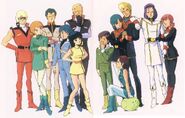| Please note that this is the Gundam Wiki's article on the TV series, Mobile Suit Zeta Gundam; if you are looking for the article on the titular mobile suit of this series then you should head to MSZ-006 Zeta Gundam. |
"Anime" is not in the list (Manga, Novel, Game, Movie, OVA, Variation, Stage Play, Documentary, TV Series, Audio Drama, ...) of allowed values for the "Media" property.
Mobile Suit Zeta Gundam (機動戦士Ζガンダム Kidō Senshi Zēta Gandamu?) (aired 1985–1986) was a fifty-episode anime series and a direct sequel to the original Mobile Suit Gundam. The show was written and directed by Yoshiyuki Tomino, with character designs by Yoshikazu Yasuhiko, while the series' mechanical designs were split amongst Kunio Okawara, Mamoru Nagano, and Kazumi Fujita. The series was originally aired by Nagoya Broadcasting Network (and it's sister ANN stations), rerun on the anime satellite television network, Animax, across Japan and later its respective networks worldwide, including Southeast Asia, East Asia, Latin America, and other regions.
Series Synopsis
It is U.C.0087, seven years after the end of the One Year War. After the events of Operation Stardust (Gundam 0083), the Earth Federation establishes an elite counter-insurgency division called the Titans to hunt down the remaining pockets of Zeon remnants. The Titans become overzealous in their mission, start resorting to brutal methods to achieve their goals, and become nothing more than ruthless tyrants with an ambition to rule the Earth Sphere. Two anti-Titans resistance groups, the AEUG (Anti-Earth Union Group) and their earth-bound counterparts Karaba (led by Mobile Suit Gundam's Hayato Kobayashi), form to unite the various existing small forces in the struggle against Titans. Their members consist of renegade soldiers of the Earth Federal forces, former soldiers of Principality of Zeon, and militia from space colonies. Most notable is Bright Noa, who returns as captain of the assault cruiser Argama, the flagship of AEUG space fleet, and Quattro Bajeena, who is really the legendary ace pilot Char Aznable, the "Red Comet".
Kamille Bidan is a troubled civilian seventeen-year old from Side 7's Green Noa 1 colony. His personal resentment towards the Titans results in him joining the AEUG. Quattro takes Kamille under his wings and becomes his mentor. The series also sees the partnership and cooperation between Kamille and Amuro, and the tension between Amuro and Char. Behind the frontline, the resistance group AEUG and Karaba are supported by many companies on Earth and in space, particularly the moon-based corporations. Besides financial support, the lunar manufacturing giant Anaheim Electronics also provides logistics and technical supports for AEUG, including spaceships, mobile suits, and munitions.
The series begins Quattro Bajeena raids the Titans military base in Green Noa 1 to acquire intelligence on a new mobile suit prototype, the "Black Gundams". Kamille, a hot-headed Newtype dissident, is caught up in the raid and helps AEUG steal the Mark-II. Eventually, he joins the AEUG, initially as the Mark-II pilot, then as the pilot of the new Ζ Gundam (made by Anaheim Electronics and based on Kamille's own design). Hayato Kobayashi and Amuro Ray meet up with them shortly after the AEUG descends on Earth to attack the Jaburo base but Amuro won't return to space. Both will stay on earth with Karaba while Hayato's son, Katz, goes to space with Quattro.
Things are complicated further as Paptimus Scirocco, a "contract killer"/mobile suit developer from the Jupiter Energy Fleet (who, unbeknownst to his government handlers, is an extremely powerful Newtype) executes his own plan. He secretly conducts a coup d'état and takes over the Titans as part of his ambition to dominate the Earth Sphere. The war between Titans and AEUG will soon escalate as Haman Karn, the true leader of Axis Zeon, joins the war as well, leading to a three-way war. In the beginning, it is not clear which side the Axis Zeon is, as Haman's cunning plan is to play AEUG and Titans against each other and take advantage of the damage from the clash between them.
Episodes
| # | Episode Title | Japanese Airdate |
|---|---|---|
| 1 | The Black Gundam | 2 March 1985 |
| 2 | Departure | 9 March 1985 |
| 3 | Inside the Capsule | 16 March 1985 |
| 4 | Emma's Decision | 23 March 1985 |
| 5 | Father and Son | 30 March 1985 |
| 6 | To Earth | 6 April 1985 |
| 7 | Escape from Side 1 | 13 April 1985 |
| 8 | The Dark Side of the Moon | 20 April 1985 |
| 9 | A New Bond | 27 April 1985 |
| 10 | Reunion | 4 May 1985 |
| 11 | Entering the Atmosphere | 11 May 1985 |
| 12 | The Winds of Jaburo | 25 May 1985 |
| 13 | Shuttle Launch | 1 June 1985 |
| 14 | Amuro Flies Again | 8 June 1985 |
| 15 | Katz's Sortie | 15 June 1985 |
| 16 | Through the Haze of Darkness | 22 June 1985 |
| 17 | Hong Kong City | 29 June 1985 |
| 18 | Mirai Captured | 6 July 1985 |
| 19 | Cinderella Four | 13 July 1985 |
| 20 | The Heated Escape | 20 July 1985 |
| 21 | A Sign of Zeta | 27 July 1985 |
| 22 | The Eyes of Scirocco | 3 August 1985 |
| 23 | Moon Attack | 10 August 1985 |
| 24 | Counterattack | 17 August 1985 |
| 25 | Colony Drop | 24 August 1985 |
| 26 | The Ghost of Zeon | 31 August 1985 |
| 27 | Rendezvous With Char | 7 September 1985 |
| 28 | The Jupitris Infiltration | 14 September 1985 |
| 29 | Crisis at Side 2 | 21 September 1985 |
| 30 | Jerid's Desperate Attack | 28 September 1985 |
| 31 | Half Moon Love | 5 October 1985 |
| 32 | Unidentified Mobile Suits | 12 October 1985 |
| 33 | The Messenger from Axis | 19 October 1985 |
| 34 | The Call of Darkness | 26 October 1985 |
| 35 | Storm Over Kilimanjaro | 2 November 1985 |
| 36 | Forever Four | 9 November 1985 |
| 37 | The Day of Dakar | 16 November 1985 |
| 38 | Reccoa's Shadow | 23 November 1985 |
| 39 | By The Lake | 30 November 1985 |
| 40 | Activation of Gryps | 7 December 1985 |
| 41 | Awakening | 14 December 1985 |
| 42 | Goodbye, Rosammy | 21 December 1985 |
| 43 | Haman's Victory | 4 January 1986 |
| 44 | The Gate of Zedan | 11 January 1986 |
| 45 | Coming From the Heavens | 18 January 1986 |
| 46 | Scirocco Rises | 25 January 1986 |
| 47 | A Descent into the Maelstrom | 1 February 1986 |
| 48 | The Mirror of Rosamia | 8 February 1986 |
| 49 | Casualties of War | 15 February 1986 |
| 50 | Riders in the Skies | 22 February 1986 |
Compilation movies: A New Translation
In celebration of Gundam's 25th anniversary (and also the 20th anniversary of Zeta Gundam), the 50-episode series was compiled into a new movie trilogy. According to Tomino, the movie series was created to fix some of the problems he identified in the Zeta TV series and to bring the 20-year-old series into a 21st-century context for the new generation now experiencing the increasingly commercialized series such as Mobile Suit Gundam SEED. The first movie, "Heirs to the Stars", opened on May 28, 2005, followed by "Lovers" on October 29, 2005, and "Love is the Pulse of the Stars" on March 6, 2006. The movies were a surprising hit, and went on to make almost 2 billion yen in box office revenue in total.
The compilations digitally remastered the TV series of Zeta Gundam with new footage. 33% of the first film was remastered footage, as well as around 70% of the second. Plot details such as the Argama's visit to the colony of 30 Bunch were changed to allow the film to flow more smoothly, unlike Tomino's previous Gundam film compilations. Also, other than Haman Karn's custom-type Gaza-C, some mobile suits that belong to the period designed after the TV version are also put into the movies such as GM Quel (Gundam 0083) as well as Gundam Hazel TR-1 (Advance of Zeta)
Like the Mobile Suit Gundam movie trilogy, the majority of the original cast of Mobile Suit Zeta Gundam reprised their roles for these theatrical versions — with the exception of Satomi Arai replacing Miyuki Matsuoka as Fa Yuiry, Yukana Nogami replacing Saeko Shimazu as Four Murasame, Yuu Asakawa replacing Kayoko Fujii as Rosamia Badam, and Chizuru Ikewaki (Lovers)/Kaori Shimamura (Love is the Pulse of the Stars) replacing Yuko Mizutani as Sarah Zabiarov.
One of the largest changes created by the movies is the ending, which changes the Universal Century timeline considerably by removing the Axis Zeon from the Earth Sphere. This results in the displacement of the original sequel to Zeta, ZZ Gundam, as well as the follow-up movie Char's Counterattack. In addition, as contrast to the original TV series, Kamille does not mentally break down due to Scirocco's mind-crippling attack. This change contributed greatly to the success at the box office since Gundam fans were curious about the new ending (though it is an expected ending from Tomino's previous comment on the movies).
The trilogy performed exceptionally well in the Japanese box office, far more so than previous efforts by a Gundam series as well as many high profile animated films such as Steamboy. This success is even more remarkable considering the film is shown in a more limited number of theaters than usual. Heirs to the Stars, the first film of A New Translation, came in 3rd place at the box office on its opening week, and the second film Lovers received similar success. One possibility for this startling success is the recent wave of nostalgia, which desires a return to the serious story-telling style of older anime. However, a good deal of New Translation's viewing demographic are of a younger generation, ranging from the late teens to early twenties.
Even more surprising is the rather high amount of female viewers, reaching 30% of the overall viewing audience. Although the core demographic is 20- to 32-year-old males still, many see this as a reminder of just how well crafted the original Gundam series were. Tomino himself, who had been wrought with a recent string of financially failed series, posted a personal "Thank you" to fans and casual moviegoers alike on A New Translation's official website.
In 2006, Bandai Entertainment acquired the rights to the U.S release of the Mobile Suit Zeta Gundam: A New Translation movie trilogy. The movies were released as a three-pack entitled Mobile Suit Gundam Zeta: Movie Complete Collection on July 6, 2010. The collection contains all three films on three DVDs with English subtitles and 5.1 Japanese surround sound.
Compiled episodes
- Heirs to the Stars (Act 1)
- Episode 1: The Black Gundam
- Episode 2: Departure
- Episode 3: Inside the Capsule
- Episode 4: Emma's Decision
- Episode 5: Father and Son
- Episode 6: To Earth
- Episode 7: Escape from Side 1
- Episode 10: Reunion
- Episode 11: Entering the Atmosphere
- Episode 12: The Winds of Jaburo
- Episode 13: Shuttle Launch
- Episode 14: Amuro Flies Again
- Lovers (Act 2)
- Episode 15: Katz's Sortie
- Episode 16: Through the Haze of Darkness
- Episode 17: Hong Kong City
- Episode 18: Mirai Captured
- Episode 19: Cinderella Four
- Episode 20: The Heated Escape
- Episode 21: A Sign of Zeta
- Episode 22: The Eyes of Scirocco
- Episode 24: Counterattack
- Episode 25: Colony Drop
- Episode 30: Jerid's Desperate Attack
- Episode 31: Half Moon Love
- Episode 32: Unidentified Mobile Suits
- Love is the Pulse of the Stars (Act 3)
- Episode 33: The Messenger from Axis
- Episode 34: The Call of Darkness
- Episode 39: By The Lake
- Episode 40: Activation of Gryps
- Episode 43: Haman's Victory
- Episode 44: The Gate of Zedan
- Episode 45: Coming From the Heavens
- Episode 46: Scirocco Rises
- Episode 47: A Descent into the Maelstrom
- Episode 49: Casualties of War
- Episode 50 (Final): Riders in the Skies
US DVD release
In 2004, after almost 2 years of delays and failed TV and merchandising deals, Bandai released a limited edition Zeta Gundam box set with both dubbed English and original Japanese audio tracks. The English dub was done by Ocean Productions with its Blue Water Studios talent pool.
Due to Bandai not having rights to the theme songs outside of Asia, the opening and closing sequences were altered, using incidental music in place of the original theme music. The English subtitles were criticized as inaccurate, and appeared to be based on the script for the English dub, rather than a direct translation of the original Japanese script. Bandai corrected the subtitles to a properly translated version for the later DVD release in 5 cases with 2 discs each, but has never officially recalled or offered to replace the box-set discs.
The box-set included pencil sharpener collectibles and a 48-page booklet and poster.
Each DVD in the Bandai Region 2 release contains five episodes as opposed to the standard three to six usually seen in single box releases.
Notes
- The first Gundam series was initially about the personal lives of the main characters. Viewers gradually learned about the political landscape where the story took place. From the first episode, Zeta Gundam displays a major conflict between political and ideological factions.
- The Earth Federation's elite Titans task force emerge as the totalitarian parallel to what the Principality of Zeon was in the original show, contrary to the Federation's previous role in Mobile Suit Gundam. The Federation has become weak and corrupt under control of the Titans' leaders. Consequently, alliances and affiliations shift: Amuro Ray, Bright Noa, Hayato Kobayashi, Kai Shiden, and Quattro Bajeena (Char Aznable) — former rivals from the previous series — now fight on the same side as the AEUG-Karaba alliance against the oppressive Titans.
- Char Aznable plays the role of mentor to new protagonist and lead character Kamille Bidan, effectively becoming the second lead character. This mentor-protege relationship plays a great role in shaping Kamille from an emotionally vulnerable, angst-ridden teenager to a true soldier.
- Untraditional to the Gundam legacy, the Gryps Conflict develops into a three-way war between AEUG, Titans, and later, Haman Karn's Axis Zeon, which culminated in the final battle Operation Maelstrom. This element of setting is later seen again in 1995's New Mobile Report Gundam Wing as a three-way conflict between the Gundam Pilots, the World Nation (led by Treize Khushrenada), and White Fang (led by Zechs Merquise), and in 1996's After War Gundam X as a three way battle between the Earth Forces, Space Forces and the main characters as a separate force. This would also return for 2002's Mobile Suit Gundam SEED as a three-way conflict between Earth Alliance, ZAFT, and Orb Union, and in 2007's Mobile Suit Gundam 00 between the Union of Solar Energy and Free Nations, Advanced European Union, and Human Reform Alliance.
- There is an extremely high number of casualties on all sides, including many main characters — another famous representation of Tomino's "Kill 'Em All" reputation.
- This is the first animated Gundam production to feature more than one Gundam mobile suit. There are four Gundams throughout this series: the Gundam Mark II, Psyco Gundam, Psyco Gundam Mk-II, and Zeta Gundam itself (some argue that the Hyaku Shiki should also be classified as a Gundam unit). Although the titular mobile suit is the Zeta Gundam, it does not appear until about halfway through the series, and the lead character Kamille Bidan pilots the Gundam Mk-II in the first half of the series.
- A large majority of the mobile suits in this series, including the titular mobile suit itself, are transformable into flight-oriented MA modes (such as the Zeta Gundam's "Waverider" mode and the Psyco Gundam's "Mobile Fortress" mode), unlike any of the suits from the original. This was later incorporated into other Gundam series, most notably Mobile Suit Gundam Wing in which the eponymous XXXG-01W Wing Gundam transforms into a "bird" mode.
- A majority of the elements of 2004's Gundam SEED Destiny, were taken and/or inspired from Zeta Gundam, such as the plotline, character roles and aliases, and mobile suit design. Also, mobile suits such as ZAKU Warrior, GOUF Ignited and DOM Trooper were taken directly out of designs from the original Mobile Suit Gundam in tribute to it.
- Several elements in Gundam 00's second season also take inspiration from Z Gundam, the most obvious of which are the establishment of the elite taskforce A-LAWS by the Earth Sphere Federation to strike down insurgencies and the resistance movement Katharon to combat the former. The A-LAWS connection is made even clearer as the group, besides holding several fanatics and outright sadists in its membership, utilizes many extremist tactics in the course of their mission (including the traditional usage of giant energy cannons to destroy civilian establishments as a show of force), and later on is given command of the ESF's regular forces just like the Titans before them.
- Of the four Gundam television series that take place in Universal Century, (Mobile Suit Gundam, Zeta Gundam, ZZ Gundam and Victory Gundam), Zeta Gundam is the only show that does not incorporate the Core Block System with its Gundams, where the Gundams break apart and reveal a hidden Core Fighter doubling as the cockpit. Instead it uses a fully-transformable system, which was very popular in 80's mecha anime. The anime Super Dimensional Fortress Macross is an example of this.
Trivia
- Love is the Pulse of the Stars was Hirotaka Suzuoki's last role as Bright Noa in the Gundam series. Suzuoki died of lung cancer on August 6, 2006 at the age of 56.
- Mobile Suit Zeta Gundam established the eventual trend of the lead pilot, with some exceptions, getting a generally-improved Gundam as main mobile suit at some point of the series, as contrast to the first Gundam series. This idea was probably extracted from Tomino's original novelisation, which had Amuro replace the RX-78-2 Gundam with the Gundam G3.
- The melodies of the TV series' two opening themes and sole ending theme were written by American pop singer/songwriter Neil Sedaka. "Zeta - Toki wo Koete" was based upon the song "Better Days are Coming" from Sedaka's 1972 album Solitaire, while "Hoshizora no Believe" was adapted from the song "Bad and Beautiful" from the 1976 album Steppin' Out. Additionally, "Mizu no Hoshi e Ai wo Komete" was derived from an unreleased song entitled "For Us to Decide".
- Apparently, the mecha design of the Zeta Gundam itself was a competition among the series designers, with Kazumi Fujita eventually winning the competition, leading to his distinctive Zeta Gundam being animated. However, rejected designs for the Zeta Gundam were animated once they were reworked, examples being the MSN-00100 Hyaku Shiki and the MRX-009 Psyco Gundam.

Walker Galia's cameo
- During episode 13, a mysterious red mobile suit can be seen in Hayato's museum. It is altered version of Walker Galia, the second protagonist mech from Combat Mecha Xabungle, another Sunrise's mecha anime directed by Yoshiyuki Tomino.
- Mobile Suit Zeta Gundam won the second place in Animage's Anime Grand Prix Award in 1985. In the same year, one of its character, Four Murasame was selected as the favorite female anime character of the year.
Opening, ending and insert songs
TV series
Opening:
- Zeta - Toki wo Koete (Z・刻をこえて; Zeta - Transcending Times) by Mami Ayukawa (Eps. 1-24)
- Mizu no Hoshi e Ai wo Komete (水の星へ愛をこめて; Towards the Aqueous Star with Love) by Hiroko Moriguchi (Eps. 25-50)
Ending:
- Hoshizora no Believe (星空のBelieve; Believe in the Starry Sky) by Mami Ayukawa
Insert:
- Gin'iro no Dress (銀色のドレス; Silver Dress) by Hiroko Moriguchi (Ep. 20)
US DVD songs:
- Zeta no Kodou ~ Zeta Gundam (Ζの鼓動~Ζガンダム; Zeta's Pulse~Zeta Gundam) by Shigeaki Saegusa (Opening)
- Green Noa no Shounen ~ Arata na Sekai (グリーン・ノアの少年~新たな世界; Boy from Green Noa ~ A New World) by Shigeaki Saegusa (Ending)
Compilation movies
Heirs To The Stars:
- Metamorphoze by Gackt (Opening)
- Kimi ga Matteiru Kara (君が待っているから; Because you're Waiting) by Gackt (Ending)
Lovers:
- Mind Forest by Gackt from his "Crescent" Album (Ending)
Love is the Pulse of the Stars:
- Love Letter by Gackt (Insert song that starts shortly before the end credits and continues as they start to roll)
- Dybbuk by Gackt (Ending, plays after Love Letter)
- All of the above songs is complied and release in Gackt's tribute album to Gundam and Z Gundam, 0079-0088
Cast
| Character | Japanese Actor | English Actor |
|---|---|---|
| Kamille Bidan | Nobuo Tobita | Jonathan Lachlan-Stewart |
| Char Aznable | Shuichi Ikeda | Tom Edwards |
| Bright Noa | Hirotaka Suzuoki | Dave Kelly |
| Emma Sheen | Maya Okamoto | Lisa Christie |
| Reccoa Londe | Masako Katsuki | Meredith Taylor-Parry |
| Fa Yuiry | Miyuki Matsuoka (TV) Satomi Arai (Movies) |
Angie Beers |
| Four Murasame | Saeko Shimazu (TV) Yukana Nogami (Movies) |
Carol-Anne Day |
| Henken Bekkener | Jurota Kosugi | David Pettitt |
| Blex Forer | Takaya Fujido (TV) Koji Ishii (Movies) |
Byron Close |
| Amuro Ray | Toru Furuya | Matthew Erickson |
| Wong Lee | Yukimasa Natori (TV) Kazumi Tanaka (Movies) |
Dean Galloway |
| Paptimus Scirocco | Bin Shimada | Jonathan Love |
| Jerid Messa | Kazuhiko Inoue | Ethan Cole |
| Mouar Pharaoh | Yoshiko Sakakibara | Jennifer Holder |
| Jamitov Hymem | Tomomichi Nishimura | Steve Olson |
| Bask Om | Daisuke Gori | Noah Umholtz |
| Yazan Gable | Houchu Ohtsuka | Corby Proctor |
| Sarah Zabiarov | Yuko Mizutani (TV) Chizuru Ikewaki (Movie 2) Kaori Shimamura (Movie 3) |
Maizun Jayoussi |
| Rosamia Badam | Kayoko Fujii (TV) Yu Asakawa (Movies) |
Valerie Howell |
| Haman Karn | Yoshiko Sakakibara | Jennifer Bain |
| Lila Milla Rira | Kimie Sawaki (TV) Mayumi Asano (Movies) |
Mechanics
AEUG
Mobile Weapons
- Junior Mobile Suit
- MS-14A Gelgoog (TV only)
- MSA-005 Methuss
- MSK-008 Dijeh (TV only)
- MSZ-006 Zeta Gundam
- RGC-83 GM Cannon II(movies only)
- RGM-79N GM Custom (movies only)
- RX-178+FXA-05D Super Gundam
Vehicles and Support Units
- Argama-class
- Space Boat
- Beechcraft Model D17 "Comet"
- Dodai Kai
- Flying Armor
- FXA-05D G-Defenser
- Garuda-class
- H.L.L.V.
- Hohsenka
- Irish-class
- Mega Bazooka Launcher
- Salamis Kai-class
- Spacejobber "Shackles"
- Suit Carrier
- Transport Ship
- XB-70 Valkyrie
Titans
Mobile Weapons
- NRX-044 Asshimar
- RX-178 Gundam Mk-II
- RMS-117 Galbaldy β
- RMS-108 Marasai
- RMS-106 Hizack
- PMX-003 The O
- RMS-154 Barzam
- RMV-1 Guntank II
- RX-77-3 Guncannon Heavy Arms Type (TV only)
- RX-110 Gabthley
- RX-121-2A Gundam TR-1 [Advanced Hazel] (movies only)
- RX-139 Hambrabi
- RX-160 Byarlant
Vehicles and Support Units
Axis Zeon
Mobile Weapons
- AMX-004 Qubeley
- AMX-003 Gaza-C
- AMX-007 Gaza-E (movies only)
- MS-21C Dra-C (movies only)
Vehicles and Support Units
Anaheim Electronics
Vehicles and Support Units
Principality of Zeon
Mobile Weapons
Vehicles and Support Units
Republic of Zeon
Mobile Weapons
Vehicles and Support Units
Gallery
See also
Manga & Novels
- Mobile Suit Gundam Zeta (Novel)
- Mobile Suit Gundam Zeta (Manga)
- Mobile Suit Zeta Gundam Awakening
- Mobile Suit Zeta Gundam Define
- Mobile Suit Z Gundam Heir to the Stars
- Mobile Suit Z Gundam II Lovers
- Mobile Suit Z Gundam III Love is the Pulse of the Stars
- Side Story of Gundam Zeta
- Mobile Suit Zeta Gundam Sayonara
- Mobile Suit Zeta Gundam: Day After Tomorrow - From Kai Shiden's Report
- Mobile Suit Zeta Gundam 1/2 UC 0087: Another Story
- Mobile Suit Gundam: The Blazing Shadow
Chronology
| Preceded by: Mobile Suit Gundam 0083: Stardust Memory |
Chronological order 0087 U.C. – 0088 U.C. |
Succeeded by: Mobile Suit Gundam ZZ |
External links
- Zeta Gundam on GundamOfficial
- Zeta Gundam Official Website (Japanese)
- AnimeChannel's Mobile Suit Z Gundam Playlist on Youtube



















